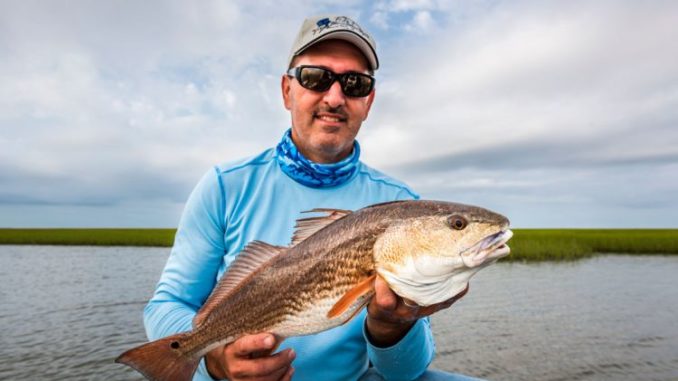
‘Hunt’ shallow flats watch redfish bite, angler says
Denham Springs’ Darren Cooper was once a die-hard bass angler, but he’s given up chasing those green fish to spend as much time at his Pointe-aux-Chenes camp catching redfish.
While he loves to catch numbers of the hard-fighting fish, Cooper has developed a knack for sight-fishing.
And, no, he’s not just looking for telltale submarine wakes or even tailing reds.
“I’m talking about seeing the fish just sitting there,” Cooper said. “The fish ain’t tailing; it’s fin isn’t sticking out of the water. I’m looking at the fish in the water.”
That means he spends most of his summer tucked into the bays and ponds of the Pointe-aux-Chenes marsh easing along shallow banks.
“I like just trolling the flats,” Cooper said.
The difference between this area and many others (like nearby Cocodrie, for instance) is that many of the interior ponds are all but inaccessible unless you have a mudboat.
“I prefer a falling tide,” Cooper said. “That’s when the water will be completely out of the grass, and the redfish have nowhere to hide.”
The angler looks for those flats covered with less than 2 feet of water, and he’s looking for crystal-clear water.
“Visibility is going to be lower in deeper water,” he said. “A redfish sitting on the bottom in more than 2 feet of water is hard to see.
“That’s the thing about sight-fishing — you get to watch the fish’s reaction.”
Bluebird days are best because clouds will obscure your view. So polarized glasses are critical, since they cut the glare of the sun and make the bronze fish stand out.
To up his odds of seeing reds before they see him, Cooper uses a collapsible three-step ladder (just like you can use in your kitchen) to get higher. He simply stows it away in a front compartment when not in use.
One of the keys is to move the boat slowly so you don’t spook fish.
“I’ve run over fish,” Cooper laughed. “You want to be able to stop the boat when you see a fish so you can work it.”
Once he’s spotted a target, the angler’s weapon of choice is a jig tipped with a Deadly Dudley or H&H cocahoe.
And he has only one color choice, no matter the brand of plastic: new moon with a chartreuse tail.
“I like that chartreuse tail — I think that’s a big part of it,” Cooper said. “that translucent (body) with the blue back, I think, sort of mimics the bait out there.”
The goal is to get his bait in the water without sending the targeted redfish streaking away, and he tried not to run the bait directly at the fish.
“You want to throw as far past the fish as possible so you don’t spook it,” Cooper explained. “I try to pull the bait within a foot of the fish. In clear water it’s not as critical to get it on its nose.”
Exactly what angle to take depends on what that red is doing. It’s really an angles game.
“I try to figure out which way it’s facing,” he said. “You don’t want to throw behind the fish; you always want to throw out front.
“If it’s swimming away from you, I try to get it within 6 inches of the fish. If it’s swimming toward you it’s the same thing — you just have to reel faster to catch up with it.”
Those fish that are just hovering in one place are the hardest to figure out — and sometimes it’s just impossible to get them to eat.
“It’s easier to catch them when they’re moving,” Cooper said. “When a fish is sitting still, they’re not as apt to bite. I’ve had fish sitting still that I couldn’t get to bite. You just sit there (with the bait) on its nose and it won’t bite.
“Eventually you get so close you end up spooking them.”
Now, the one thing to keep in mind is that this isn’t a numbers deal. Cooper rarely makes a cast unless he’s targeting a fish he’s located — unless he hasn’t seen a fish in a while and just makes a blind cast out of boredom.
“You may troll for half hour without making a cast,” he said.
So why is he satisfied catching a handful of fish a day when he could catch more fish by just running the banks and blind-casting.
“I guess it’s kind of the challenge,” Cooper said. “It’s more along the lines of hunting — find your prey and cash in on it.
“It’s more of an accomplishment when you catch one.”